定冠词the与指示代词this
- 格式:doc
- 大小:40.50 KB
- 文档页数:4
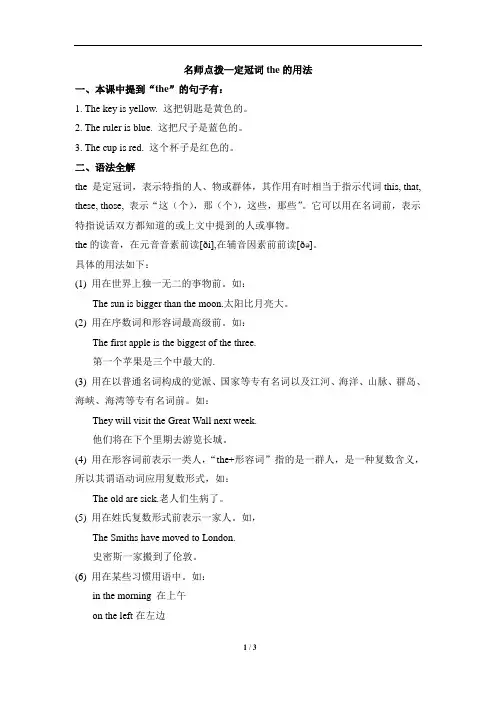
名师点拨—定冠词the的用法一、本课中提到“the”的句子有:1. The key is yellow. 这把钥匙是黄色的。
2. The ruler is blue. 这把尺子是蓝色的。
3. The cup is red. 这个杯子是红色的。
二、语法全解the 是定冠词,表示特指的人、物或群体,其作用有时相当于指示代词this, that, these, those, 表示“这(个),那(个),这些,那些”。
它可以用在名词前,表示特指说话双方都知道的或上文中提到的人或事物。
the的读音,在元音音素前读[ði],在辅音因素前前读[ðə]。
具体的用法如下:(1) 用在世界上独一无二的亊物前。
如:The sun is bigger than the moon.太阳比月亮大。
(2) 用在序数词和形容词最高级前。
如:The first apple is the biggest of the three.第一个苹果是三个中最大的.(3) 用在以普通名词构成的觉派、国家等专有名词以及江河、海洋、山脉、群岛、海峡、海湾等专有名词前。
如:They will visit the Great Wall next week.他们将在下个里期去游览长城。
(4) 用在形容词前表示一类人,“the+形容词”指的是一群人,是一种复数含义,所以其谓语动词应用复数形式,如:The old are sick.老人们生病了。
(5) 用在姓氏复数形式前表示一家人。
如,The Smiths have moved to London.史密斯一家搬到了伦敦。
(6) 用在某些习惯用语中。
如:in the morning 在上午on the left在左边the day before yesterday 前天all the same 仍然另外,有些词或短语前既不用不定冠词a/an,也不用定冠词the,像这种不用冠词的情况,称为零冠词。
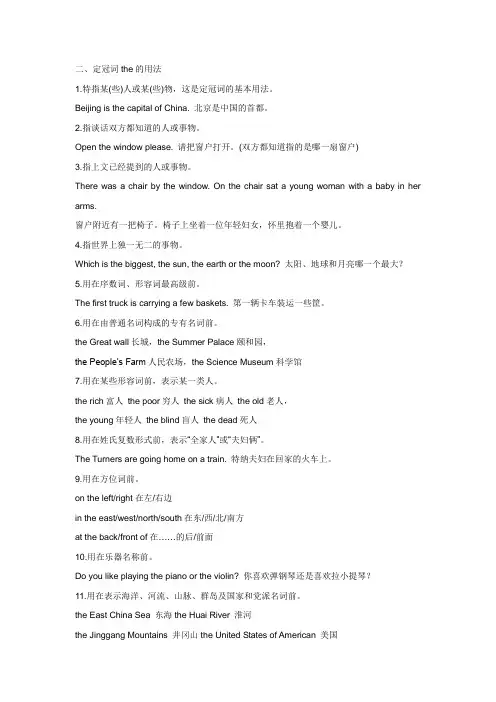
二、定冠词the的用法1.特指某(些)人或某(些)物,这是定冠词的基本用法。
Beijing is the capital of China. 北京是中国的首都。
2.指谈话双方都知道的人或事物。
Open the window please. 请把窗户打开。
(双方都知道指的是哪一扇窗户)3.指上文已经提到的人或事物。
There was a chair by the window. On the chair sat a young woman with a baby in her arms.窗户附近有一把椅子。
椅子上坐着一位年轻妇女,怀里抱着一个婴儿。
4.指世界上独一无二的事物。
Which is the biggest, the sun, the earth or the moon? 太阳、地球和月亮哪一个最大?5.用在序数词、形容词最高级前。
The first truck is carrying a few baskets. 第一辆卡车装运一些筐。
6.用在由普通名词构成的专有名词前。
the Great wall长城,the Summer Palace颐和园,the People’s Farm人民农场,the Science Museum科学馆7.用在某些形容词前,表示某一类人。
the rich富人the poor穷人the sick病人the old老人,the young年轻人the blind盲人the dead死人8.用在姓氏复数形式前,表示“全家人”或“夫妇俩”。
The Turners are going home on a train. 特纳夫妇在回家的火车上。
9.用在方位词前。
on the left/right在左/右边in the east/west/north/south在东/西/北/南方at the back/front of在……的后/前面10.用在乐器名称前。
Do you like playing the piano or the violin? 你喜欢弹钢琴还是喜欢拉小提琴?11.用在表示海洋、河流、山脉、群岛及国家和党派名词前。
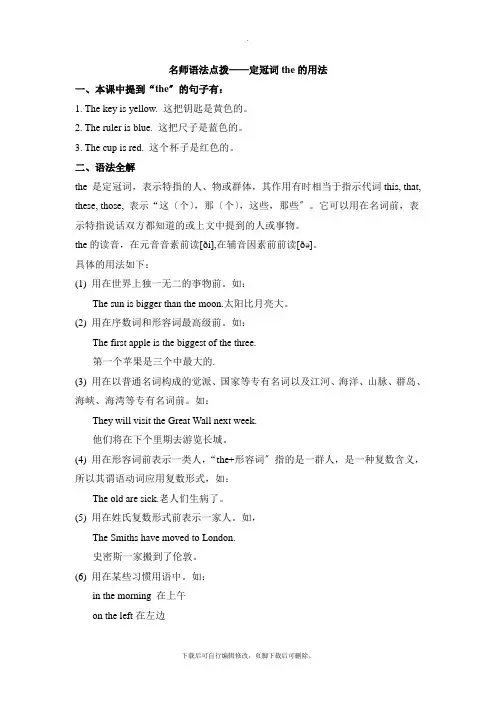
名师语法点拨——定冠词the的用法一、本课中提到“the〞的句子有:1. The key is yellow. 这把钥匙是黄色的。
2. The ruler is blue. 这把尺子是蓝色的。
3. The cup is red. 这个杯子是红色的。
二、语法全解the 是定冠词,表示特指的人、物或群体,其作用有时相当于指示代词this, that, these, those, 表示“这〔个〕,那〔个〕,这些,那些〞。
它可以用在名词前,表示特指说话双方都知道的或上文中提到的人或事物。
the的读音,在元音音素前读[ði],在辅音因素前前读[ðə]。
具体的用法如下:(1) 用在世界上独一无二的亊物前。
如:The sun is bigger than the moon.太阳比月亮大。
(2) 用在序数词和形容词最高级前。
如:The first apple is the biggest of the three.第一个苹果是三个中最大的.(3) 用在以普通名词构成的觉派、国家等专有名词以及江河、海洋、山脉、群岛、海峡、海湾等专有名词前。
如:They will visit the Great Wall next week.他们将在下个里期去游览长城。
(4) 用在形容词前表示一类人,“the+形容词〞指的是一群人,是一种复数含义,所以其谓语动词应用复数形式,如:The old are sick.老人们生病了。
(5) 用在姓氏复数形式前表示一家人。
如,The Smiths have moved to London.史密斯一家搬到了伦敦。
(6) 用在某些习惯用语中。
如:in the morning 在上午on the left在左边the day before yesterday 前天all the same 仍然另外,有些词或短语前既不用不定冠词a/an,也不用定冠词the,像这种不用冠词的情况,称为零冠词。
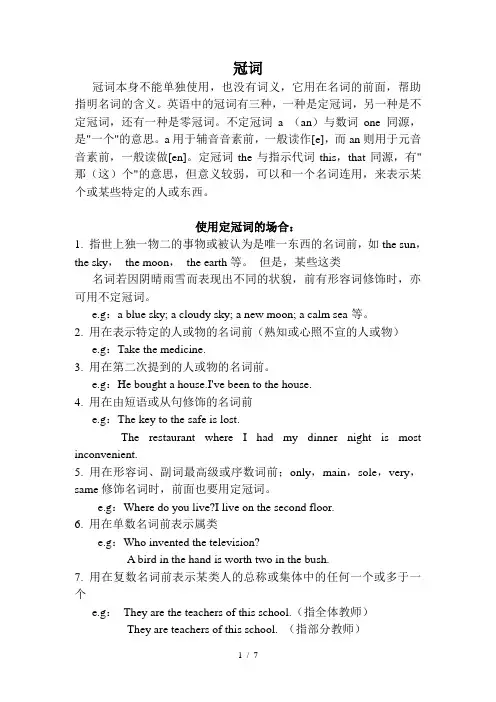
冠词冠词本身不能单独使用,也没有词义,它用在名词的前面,帮助指明名词的含义。
英语中的冠词有三种,一种是定冠词,另一种是不定冠词,还有一种是零冠词。
不定冠词a (an)与数词one 同源,是"一个"的意思。
a用于辅音音素前,一般读作[e],而an则用于元音音素前,一般读做[en]。
定冠词the与指示代词this,that同源,有"那(这)个"的意思,但意义较弱,可以和一个名词连用,来表示某个或某些特定的人或东西。
使用定冠词的场合:1. 指世上独一物二的事物或被认为是唯一东西的名词前,如the sun,the sky,the moon,the earth等。
但是,某些这类名词若因阴晴雨雪而表现出不同的状貌,前有形容词修饰时,亦可用不定冠词。
e.g:a blue sky; a cloudy sky; a new moon; a calm sea等。
2. 用在表示特定的人或物的名词前(熟知或心照不宣的人或物)e.g:Take the medicine.3. 用在第二次提到的人或物的名词前。
e.g:He bought a house.I've been to the house.4. 用在由短语或从句修饰的名词前e.g:The key to the safe is lost.The restaurant where I had my dinner night is most inconvenient.5. 用在形容词、副词最高级或序数词前;only,main,sole,very,same修饰名词时,前面也要用定冠词。
e.g:Where do you live?I live on the second floor.6. 用在单数名词前表示属类e.g:Who invented the television?A bird in the hand is worth two in the bush.7. 用在复数名词前表示某类人的总称或集体中的任何一个或多于一个e.g:They are the teachers of this school.(指全体教师)They are teachers of this school. (指部分教师)8. 用在形容词、动名词、过去分词前表示同一类人或物或某种抽象概念。
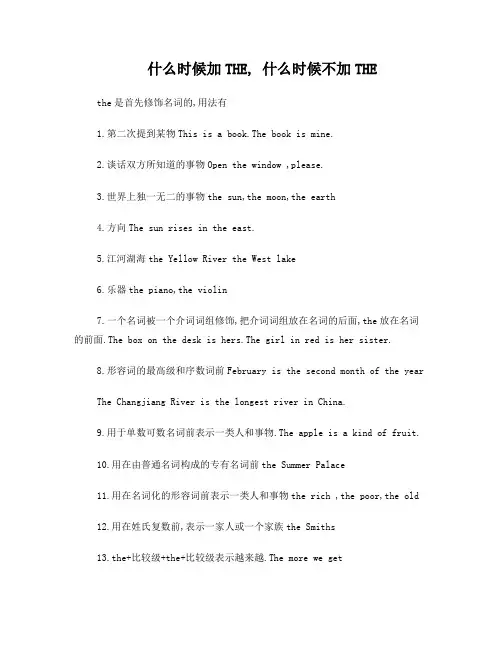
什么时候加THE, 什么时候不加THE the是首先修饰名词的,用法有1.第二次提到某物This is a book.The book is mine.2.谈话双方所知道的事物Open the window ,please.3.世界上独一无二的事物the sun,the moon,the earth4.方向The sun rises in the east.5.江河湖海the Yellow River the West lake6.乐器the piano,the violin7.一个名词被一个介词词组修饰,把介词词组放在名词的后面,the放在名词的前面.The box on the desk is hers.The girl in red is her sister.8.形容词的最高级和序数词前February is the second month of the yearThe Changjiang River is the longest river in China.9.用于单数可数名词前表示一类人和事物.The apple is a kind of fruit.10.用在由普通名词构成的专有名词前the Summer Palace11.用在名词化的形容词前表示一类人和事物the rich ,the poor,the old12.用在姓氏复数前,表示一家人或一个家族the Smiths13.the+比较级+the+比较级表示越来越.The more we gettogether,the happier we will be.不用有1第一次提到某物2,谈话人所不知道的事物3,表示数量单位4,感叹句免冠的情况(不用the ,a ,an )代词限定名词前复数名词表泛指学科球类三餐饭颜色,语种及国名,称呼,习语及头衔.定冠词的用法定冠词the与指示代词this,that同源,有"那(这)个"的意思,但较弱,可以和一个名词连用,来表示某个或某些特定的人或东西。
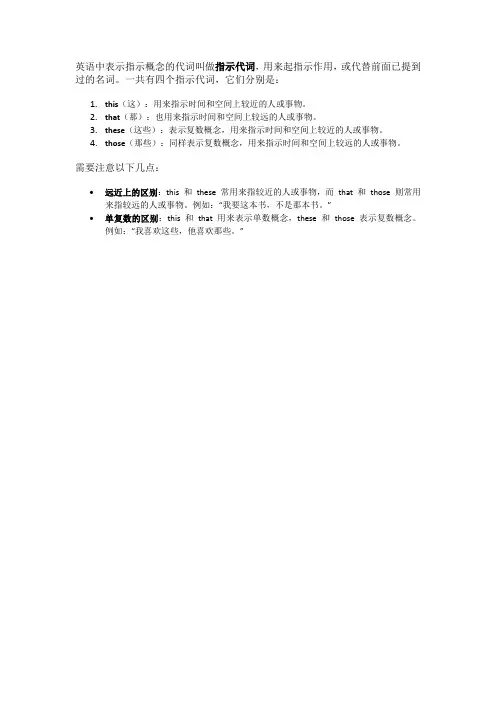
英语中表示指示概念的代词叫做指示代词,用来起指示作用,或代替前面已提到过的名词。
一共有四个指示代词,它们分别是:
1.this(这):用来指示时间和空间上较近的人或事物。
2.that(那):也用来指示时间和空间上较远的人或事物。
3.these(这些):表示复数概念,用来指示时间和空间上较近的人或事物。
4.those(那些):同样表示复数概念,用来指示时间和空间上较远的人或事物。
需要注意以下几点:
•远近上的区别:this 和these 常用来指较近的人或事物,而that 和those 则常用来指较远的人或事物。
例如:“我要这本书,不是那本书。
”
•单复数的区别:this 和that 用来表示单数概念,these 和those 表示复数概念。
例如:“我喜欢这些,他喜欢那些。
”。

不定冠词表示泛指,定冠词表示特指。
不定冠词a (an)与数词one 同源,是"一个"的意思。
a用于辅音音素前,一般读作[e],而an则用于元音音素前,一般读做[en]。
1) 表示"一个",意为one;指某人或某物,意为a certain。
A Mr. Ling is waiting for you.2) 代表一类人或物A knife is a tool for cutting with.Mr. Smith is an engineer.定冠词the与指示代词this,that同源,有"那(这)个"的意思,但较弱,可以和一个名词连用,来表示某个或某些特定的人或东西。
定冠词的用法:1)特指双方都明白的人或物:Take the medicine. 把药吃了。
2)上文提到过的人或事:He bought a house. I've been to the house.他买了幢房子。
我去过那幢房子。
3)指世上独一物二的事物:the sun,the sky,the moon,the earth4)单数名词连用表示一类事物,如:the dollar 美元;the fox 狐狸;或与形容词或分词连用,表示一类人:the rich 富人; the living 生者。
5)用在序数词和形容词最高级,及形容词only,very,same等前面:Where do you live? I live on the second floor. 你住在哪?我住在二层。
That's the very thing I've been looking for. 那正是我要找的东西。
6)与复数名词连用,指整个群体:They are the teachers of this school.指全体教师)They are teachers of this school. (指部分教师)7)表示所有,相当于物主代词,用在表示身体部位的名词前:She caught me by the arm..她抓住了我的手臂。
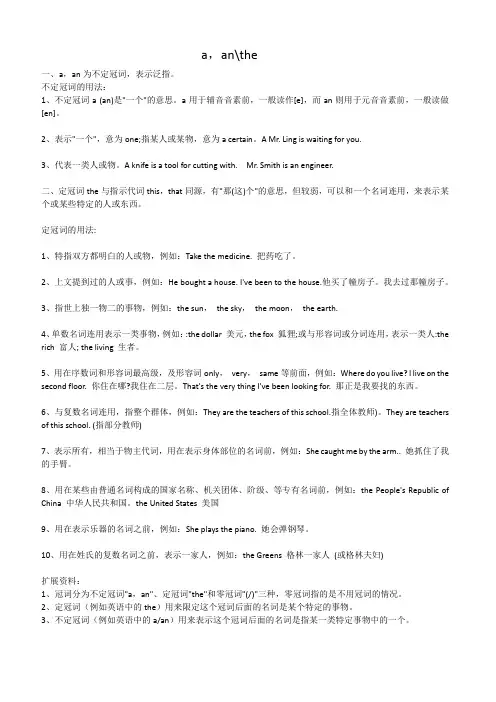
a,an\the一、a,an为不定冠词,表示泛指。
不定冠词的用法:1、不定冠词a (an)是"一个"的意思。
a用于辅音音素前,一般读作[e],而an则用于元音音素前,一般读做[en]。
2、表示"一个",意为one;指某人或某物,意为a certain。
A Mr. Ling is waiting for you.3、代表一类人或物。
A knife is a tool for cutting with. Mr. Smith is an engineer.二、定冠词the与指示代词this,that同源,有"那(这)个"的意思,但较弱,可以和一个名词连用,来表示某个或某些特定的人或东西。
定冠词的用法:1、特指双方都明白的人或物,例如:Take the medicine. 把药吃了。
2、上文提到过的人或事,例如:He bought a house. I've been to the house.他买了幢房子。
我去过那幢房子。
3、指世上独一物二的事物,例如:the sun,the sky,the moon,the earth.4、单数名词连用表示一类事物,例如::the dollar 美元,the fox 狐狸;或与形容词或分词连用,表示一类人:the rich 富人; the living 生者。
5、用在序数词和形容词最高级,及形容词only,very,same等前面,例如:Where do you live? I live on the second floor. 你住在哪?我住在二层。
That's the very thing I've been looking for. 那正是我要找的东西。
6、与复数名词连用,指整个群体,例如:They are the teachers of this school.指全体教师)。
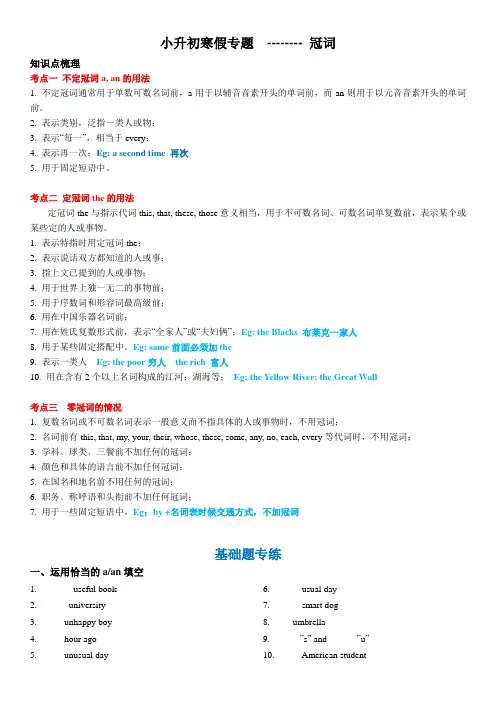
小升初寒假专题-------- 冠词知识点梳理考点一不定冠词a, an的用法1. 不定冠词通常用于单数可数名词前,a用于以辅音音素开头的单词前,而an则用于以元音音素开头的单词前。
2. 表示类别,泛指一类人或物;3. 表示“每一”,相当于every;4. 表示再一次;Eg: a second time 再次5. 用于固定短语中。
考点二定冠词the的用法定冠词the与指示代词this, that, these, those意义相当,用于不可数名词、可数名词单复数前,表示某个或某些定的人或事物。
1. 表示特指时用定冠词the;2. 表示说话双方都知道的人或事;3. 指上文已提到的人或事物;4. 用于世界上独一无二的事物前;5. 用于序数词和形容词最高级前;6. 用在中国乐器名词前;7. 用在姓氏复数形式前,表示“全家人”或“夫妇俩”;Eg: the Blacks 布莱克一家人8. 用于某些固定搭配中。
Eg: same前面必须加the9. 表示一类人Eg: the poor穷人the rich 富人10. 用在含有2个以上名词构成的江河;湖海等;Eg: the Yellow River; the Great Wall考点三零冠词的情况1. 复数名词或不可数名词表示一般意义而不指具体的人或事物时,不用冠词;2. 名词前有this, that, my, your, their, whose, these, some, any, no, each, every等代词时,不用冠词;3. 学科﹑球类﹑三餐前不加任何的冠词;4. 颜色和具体的语言前不加任何冠词;5. 在国名和地名前不用任何的冠词;6. 职务﹑称呼语和头衔前不加任何冠词;7. 用于一些固定短语中。
Eg:by +名词表时候交通方式,不加冠词基础题专练一、运用恰当的a/an填空1. _______ useful book2. ______ university3. _____ unhappy boy4. _____ hour ago5. _____ unusual day6. ______ usual day7. ______ smart dog8. ____ umbrella9. ______”s” and ______”u”10. _____ American student11. _____ English book12. give me ______ cup of coffee13. ______ good boy14. _____ orange15. ______ egg 16. _____ student17. miss ______”m”18. ______ one-year-old baby19. half ______ hour20. _____ honest boy二、用适当的冠词填空1. This is ___ old map. It is ____ useful map.2. _____Blacks are sitting in the living room.3. Which is ________ biggest, ______ sun, _______ moon; or ______ earth?4. This is _______ useful book. I read it for _______ hour.5. There is _____woman over there. ____ woman is Lily’s mother .6. What _____ important news!7. He often goes to _____ school by ____ bike.8. I often watch _____ TV in _____ evening.9. There is _____”s” and _____”m” in _____word”miss.”10. Do n’t play _____ basketball at home. You can play _____ guitar.11. Are ____ Greens going to Shanghai for holiday?12. It will take you half ____ hour together there on ____ bus.13. Let’s go out for _____ walk.st night I saw________ UFO flying in the sky and took pictures of it.15. Tim had tried twice, and his father asks him to have________ third try.16. Many students in our school can play________ guitar.17. Liu Changchun is________ first Chinese to join the Olympics.18. I think it’s________ useful advice, so I will always remember it.19. —Will you get there by________ train? —No, I’ll take _______ taxi.20. We work five days ________ week.21. There’s _______ “u” and _______ “s” in ______ word “use”.22. That’s ______ useful book. I have read it already.23. ______ Whites have moved to a new house.提高题精练1. --- What _______ great time they had at the party yesterday!A. aB. theC. anD. /2. What ____ great fun they had at the party yesterday!A. aB. theC. anD. /3. We’ll go traveling by ____ camel across the desert before we go to ____ university.A. a; /B. /; anC. /; /D. /; a4. ____ Greens are preparing for the coming Thanksgiving Day.A. aB. theC. anD. /5. This summer, I’m going to visit _____ Great Wall.A. aB. theC. anD. /6. ____ apple a day keeps the doctor away.A. AnB. TheC. AD. /7. At that time, Tom was _____ one-year-old baby.A. aB. theC. anD. /8. ____ useful book it is!A. What aB. How aC. What anD. What9. One afternoon, he found ____ handbag. There was ____”s” on the corner of _____ handbag.A. a; a; theB. a; an; theC. an; an; aD. the; an; the10. ____ Great Wall is ____ longest wall in the world.A. The; aB. The; aC. /; /D. The; the11. The museum is quite far. It will take you half ____hour to get there by ____ bus.A. an; aB. a; aC. an; /D. /; a12. ___ elephant is much heavier than _____ horse.A. A; aB. The; theC. An; aD. /; /13. Washington is _____ capital of ____ USA.A. the; theB. a; theC. a; /D. the; /14. After watching TV, she played ____ violin for _____ hour.A. the; theB. a; theC. a; aD. the; an15. Susan, _____ university student from Europe, teaches me _____ art in her free time.A. an; /B. a; theC. a; /D. a; a16. Now he is _____ artist. I have known him(认识)since(自从) he was _____ one –year-old boy.A. a; anB. an; aC. an; anD. a; a17. We found that we should do more for _______ poor in the poor area.A. /B. aC. theD. those18. They went to see _____Yellow River two days ago. And they arrived(到达) ______ home yesterday.A. the; /B./; theC. /; /D. the; the19. The boy is on ____ left of that boy. And two boys look ____ same.A. the; theB. /; /C. a; aD. the; /20. We should give the seats to _______ elderly on the bus.A. theB. /C. aD. an21. _____ Browns live in ___United States.A. The; theB. /; /C. A; aD. the; /22. _____ Spring Festival is ____ most important holiday in _____ China.A. The; the; theB. /; /; theC. A; a; /D. The; the; /23. Do you like studying _____Maths or ______Chinese?A. the; theB. /; /C. a; aD. the; /24. I think it is _____ hard work for me to finish the job in twenty minutes.A. theB. /C. aD. an25. Does Wuxi have_____ airport? --- Yes, we can go to ____ UK on ____ plane.A. a; the; /B. an; the; theC. the; the; aD. the; the; /基础题专练答案一、运用恰当的a/an填空1~ 10 : A; a; an; an; an; a; a; an; an, a; an;11~20: an; a; a; an; an; a; an; a; an ;an二、用适当的冠词填空1. an; a2. The3. the; the; the ; the4. a; an5. a; The6. /7. /; /8. /; the9. an; an; the 10. /; the 11. the 12. an; the 13. a 14.a 15. a 16. the 17. the 18. / 19. /; a 20.a21. a; an; the 22. a 23. The提高题精练ADDBB AAABD CCADC BCAAA ADBBB。
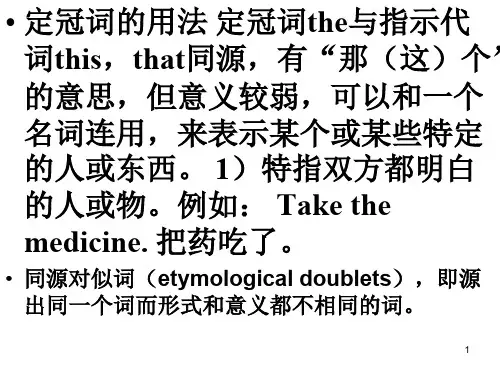
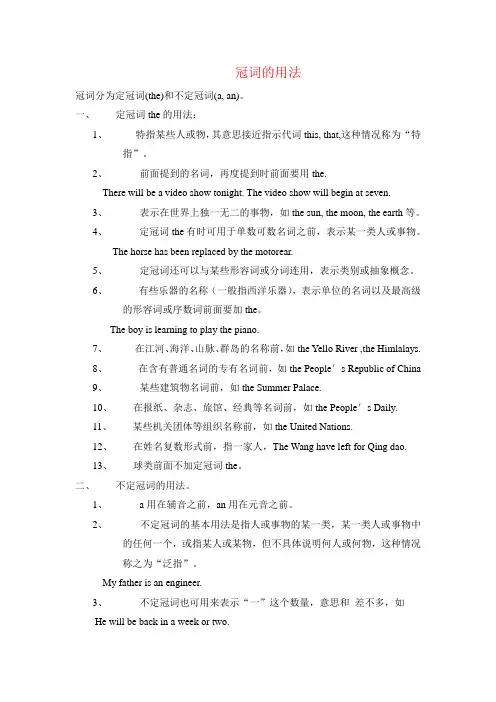
冠词的用法冠词分为定冠词(the)和不定冠词(a, an)。
一、定冠词the的用法:1、特指某些人或物,其意思接近指示代词this, that,这种情况称为“特指”。
2、前面提到的名词,再度提到时前面要用the.There will be a video show tonight. The video show will begin at seven.3、表示在世界上独一无二的事物,如the sun, the moon, the earth等。
4、定冠词the有时可用于单数可数名词之前,表示某一类人或事物。
The horse has been replaced by the motorear.5、定冠词还可以与某些形容词或分词连用,表示类别或抽象概念。
6、有些乐器的名称(一般指西洋乐器),表示单位的名词以及最高级的形容词或序数词前面要加the。
The boy is learning to play the piano.7、在江河、海洋、山脉、群岛的名称前,如the Y ello River ,the Himlalays.8、在含有普通名词的专有名词前,如the People′s Republic of China9、某些建筑物名词前,如the Summer Palace.10、在报纸、杂志、旅馆、经典等名词前,如the People′s Daily.11、某些机关团体等组织名称前,如the United Nations.12、在姓名复数形式前,指一家人,The Wang have left for Qing dao.13、球类前面不加定冠词the。
二、不定冠词的用法。
1、a用在辅音之前,an用在元音之前。
2、不定冠词的基本用法是指人或事物的某一类,某一类人或事物中的任何一个,或指某人或某物,但不具体说明何人或何物,这种情况称之为“泛指”。
My father is an engineer.3、不定冠词也可用来表示“一”这个数量,意思和差不多,如He will be back in a week or two.4、有些物质名词或抽象名词加a(n)可具体化,变成普通名词,表示一个具体情况或动作或某一类物质,如Maotai is a famous Chineseliquer.Have或tak e+a+抽象名词,与抽象名词的动词形式同一意思,如,Let us have a talk=Let us talk.三、冠词的省略。
英语定冠词用法分析冠词是一种虚词,本身不能单独使用,也没有词义,只能帮助名词或起名词作用的其它词类说明其意义。
英语中的冠词有两个:一个是定冠词,一个是不定冠词,下面主要来分析一下有关定冠词的用法。
定冠词“the”来源于古英语指示代词,是this或that的弱式,表示概念较弱,它可以放在单数可数名词、复数可数名词以及不可数名词之前。
定冠词只有一种书写形式,但其发音则有三种形式,在辅音开头的词前弱读为〔〕;在元音开头的词前重读为〔i〕,特别强调时读为〔i:〕。
例如:the hospital〔〕the outstandingworker〔i〕一般情况下,定冠词能用于各类名词(大多数专有名词除外),并可搭配使用,定冠词的基本用法包括概括用法、特指用法、类指用法、副词用法、重复用法、专有名词与定冠词之间的搭配以及定冠词的一些特殊用法。
1 定冠词的概括用法当定冠词表示概括含义时,与不定冠词的概括意义(尚不分析)相仿,两者常可通用。
A lion is a beastof prey可改为The lion is a beastofprey,两句意思基本上相同,用了定冠词the似乎使概括全类属的语气加重,含有“彼类”、“此类”相比较进而强调了全类事物的共同性质、特征,或者使得同类中的个体更加突出。
下面具体分析一下概括用法:(1)用在表示一类事物或人的前面The wolf is a cunning animal.Adoctor’s duty is to heal thewounded and rescue the dying.(2)与某些形容词或分词连用,代表整个类别或某一抽象概念。
There will always be such opposites as the right and the wrong the good and the evil, the beautiful and the ugly.同样定冠词与表示民族(或国籍)的形容词连用代表整个民族(或该国人)。
★以下是⽆忧考英语资源频道为⼤家整理的《英语语法:指⽰代词及其运⽤》,供⼤家参考。
指⽰代词(demonstrative pronoun)是表⽰指⽰概念的代词,即⽤来指⽰或标识⼈或事物的代词。
指⽰代词与定冠词和⼈称代词⼀样,都具有指定的含义,⽤来起指⽰作⽤,或⽤来代替前⾯已提到过的名词。
⼀:指⽰代词 1.指⽰代词有this , that , these , those , such , same. 2.指⽰代词的⽤法: (1).that 常⽤来代替前⾯出现的⼈.事. 物,以免重复.that代替可数名词和不可数名词;those可代替复数名词. 2.指⽰代词的⽤法: (1).that 常⽤来代替前⾯出现的⼈.事.物,以免重复.that代替可数名词和不可数名词;those可代替复数名词. (2). 在打电话时,英语中常⽤this代替⾃⼰,that代替对⽅.例如: A: May I speak to Mr. Zhang, please? B: This is Zhang Ming speaking. Who’s that. (3). Such表⽰ “如此,这样的⼈或事”. I have never seen such an interesting film before. (4). Same 表⽰ “ 同样的⼈和物”,前⾯必须加the.例如: They arrived there at the same time. Lucy and Lily are in the same class. They do the same thing everyday. 经典例析 1.The weather in Australia is quite different from ___ of Shijiazhuang. A. it B. that C. those D. ones 2. The cars made in Japan are much cheaper than __ made in America. A. ones B. those C. that D. it 3.Can you believe that in _____ a rich country there should be ____ many poor people ? A. such such B. such so C. so so D. so such 4. ---Hello! May I speak to Jim, please? --- Speaking.___________? A. how are you B. Is that Mike C. are you Jim D. who are you 5. There are more people in Shanghai than in Tianjin. (同义句) The ____________ of shanghai is _______ than ______ of Tianjin. 6. This is the most interesting book that I have ever read.(同义句) I have _______ read _______ an interesting book before.。
七年级上Starter Unit 3 定冠词the的用法【教材典句】1.The key is yellow. 这把钥匙是黄色的。
2.The ruler is blue. 这把尺子是蓝色的。
3.The cup is red. 这个杯子是红色的。
【语法全解】the是定冠词,表示特指的人、物或群体,其作用有时相当于指示代词this,that,these,those,表示“这(个),那(个),这些,那些”。
它可以用在名词前,表示特指说话双方都知道的或上文提到的人或事物。
the 的读音:在元音音素前读/δi/,在辅音音素前读/δə/。
具体用法如下:1.和个体名词的单数或复数连用,表示某个(些)特定的人或事物Give me the book. 把那本书给我。
2.特指说话双方都知道的人或事物Where is the ruler? 尺子在哪里?3.指上文提到的人或事物This is a pen. The pen is black. 这是一支钢笔。
这支钢笔是黑色的。
4.用在世界上独一无二的事物前the sun 太阳the earth 地球the moon 月亮the world 世界5.和某些形容词连用,表示一类人the old 老人the young 年轻人the poor 穷人6.用在方位名词前the east 东方the west 西方7.与play 连用时,用在西洋乐器名词前play the piano 弹钢琴8.与专有名词连用the Great Wall 长城the Summer Palace 颐和园9.用在一些固定短语中in the morning/afternoon/evening 在上午/下午/晚上定冠词the的用法特指双方熟悉,上文已经提及。
世上独一无二,某些专有名词。
方位名词乐器,习惯用语要特记。
【语法专练】1.-- John, may I use your car? I want to go to the library.-- Sure. Here is key.A. aB. anC. theD. /2. Do you know girl in green? She is our monitor(班长).A. aB. anC. theD. /3. This is a pen. pen is yellow.A. AB. AnC. TheD. /4.Where is jacket, please?A. theB. aC. /D.an5.sun is red. It is very beautiful.A. /B. AC. TheD. An6.Can you play guitar?A. aB. theC. /D. an7.Don’t you know girl under the tree? She is our teacher’s daughter.A. aB. anC. theD. /。
定冠词the的用法:定冠词the与指示代词this ,that同源,有“那(这)个”的意思,但较弱,可以和一个名词连用,来表示某个或某些特定的人或东西.(1)特指双方都明白的人或物Take the medicine.把药吃了.(2)上文提到过的人或事He bought a house.他买了幢房子.I've been to the house.我去过那幢房子.(3)指世界上独一无二的事物the sun ,the sky ,the moon, the earth(4)单数名词连用表示一类事物the dollar 美元the fox 狐狸或与形容词或分词连用,表示一类人the rich 富人the living 生者(5)用在序数词和形容词最高级,及形容词等前面Where do you live?你住在哪?I live on the second floor.我住在二楼.That's the very thing I've been looking for.那正是我要找的东西.(6)与复数名词连用,指整个群体They are the teachers of this school.(指全体教师)They are teachers of this school.(指部分教师)(7)表示所有,相当于物主代词,用在表示身体部位的名词前She caught me by the arm.她抓住了我的手臂.(8)用在某些有普通名词构成的国家名称,机关团体,阶级等专有名词前the People's Republic of China 中华人民共和国the United States 美国(9)用在表示乐器的名词前She plays the piano.她会弹钢琴.(10)用在姓氏的复数名词之前,表示一家人the Greens 格林一家人(或格林夫妇)(11)用在惯用语中in the day, in the morning...the day before yesterday, the next morning...in the sky...in the dark...in the end...on the whole, by the way...a与an的用法区别a用于辅音前;an用于元音前.一般说来,元音字母发元音,辅音字母发辅音,但需请注意以下3点:1.拼写以辅音字母开头读音却以元音开头的单词hour,honest,honor等单词的拼写虽然以辅音字母h开头,但其读音却以元音开头,因此,前面要用等单词的拼写虽然以辅音字母an.可熟记下面这句话:An hour ago,an honest man accepted an honorable task.(一小时前,一位诚实的人接受了一项光荣的任务.)2.拼写以元音字母开头读音却以辅音开头的单词useful,university,usual,European,united,one-eyed,one-way等单词的拼写虽然以元音字母开头,但其读音却以元音开头,因此,前面要用a等单词的拼写虽然以元音字母开头,但其读音却以元.可熟记下面这句话:In a university,a European and a one-eyed man walk along a one-way road with a usual tool.This is a usual thing.(在一所大学里,有一个欧洲人和一个独眼龙拿着有用的工具沿着一条单行道行走,这是件平常的事.)如:Five years ago her brother was ________ university student of ________ physics.(上海卷))A.a; theB.an; theC.an; /D.a; /【分析】答案选D.因为university是以辅音[j]开头的要用a,排除B和C;physics是学科名词,前面不用冠词.3.英文字母前用a还是用an的问题在26个英文字母中,a,e,i,o,f,h,l,m,n,r,s,x等12个字母的读音是以元音开头的,其余字母则是以辅音开头的.如:Please pay attention to your spelling.You have dropped ________ ”m” here.(全国卷)A.anB.theC./D.a【分析】答案选A.因为字母答案选m的发音是以元音[e]开头的,所以用an;这里的an的意义与one相当,表示“一个”.不定冠词a(an)的用法1.表示“一”这个数量概念,比one意思稍弱e.g.:The plan will be ready in a week or two.2.表示某人或某物,但不具体说明哪个,相当于anye.g.:This poem was written by a student.注:在1,2两项中,如果名词变复数,把a换成数词或不定代词some,any等即可.e.g.:The plan will be ready in three weeks.3.表示某一类人或事物e.g.:Even a child can answer this question.注:句中名词变复数时,去掉不定冠词a/an即可.4.和表示时间或度量衡的名词连用表示“每日”、“每斤”等e.g.:I take a two-mile walk twice a day.5.用于固定词组e.g.:have/take a shower have/take a bathtake a walk give a lecturea lot of a couple ofas a rule have a headachea few a little a bit6.不定冠词用于有形容词修饰的季节,日期前面The traffic accident happened on a Sunday towards the end of July.英语中哪些情况在名词前不用加冠词1)国名,人名前通常不用定冠词:England ,Mary;2)泛指的复数名词,表示一类人或事物时,可不用定冠词;They are teachers.他们是教师.3)抽象名词表示一般概念时,通常不加冠词;Failure is the mother of success.失败乃成功之母.4)物质名词表示一般概念时,通常不加冠词,当表示特定的意思时,需要加定冠词;Man cannot live without water.人离开水就无法生存.5)在季节、月份、节日、假日、日期、星期等表示时间的名词之前,不加冠词;We go to school from Monday to Friday.我们从星期一到星期五都上课.6)在称呼或表示官衔,职位的名词前不加冠词;The guards took the American to General Lee.士兵们把这个美国人送到李将军那里.7)在三餐、球类运动和娱乐运动的名称前,不加冠词如:have breakfast,play chess8)当两个或两个以上名词并用时,常省去冠词;I can't write without pen or pencil.没有钢笔和铅笔,我就写不了字.9)当by 与火车等交通工具连用,表示一种方式时,中间无冠词;by bus,by train;10)有些个体名词不用冠词;如:school,college,prison,market,hospital,bed,table,class,town,church,court 等个体名词,直接置于介词后,表示该名词的深层含义;go to hospital去医院看病go to the hospital去医院(并不是去看病,而是有其他目的)11)不用冠词的序数词;a.序数词前有物主代词b.序数词作副词He came first in the race.c.在固定词组中at (the) first,first of all,from first to last1. When Linda was a child, her mother always let her have ______ bed.A. the breakfast inB. the breakfast in theC. breakfast inD. breakfast in the2. Beyond ______ stars the astronaut saw nothing but ______ space.A. the, 不填B. 不填,theC. 不填,不填D. the, the3. Alexander Graham Bell invented ________ telephone in 1876.A. 不填B. aC. theD. one4. After watching ____ TV, she played _____ violin for an hour.A. 不填,不填B. the, theC. the, 不填D. 不填,the5. Many people are still in ____ habit of writing silly things in ____ public places.A. the, theB. 不填,不填C. the, 不填D. 不填,the6. Paper money was in ____ use in China when Marco Polo visited the country in ____ thirteenth century.A. the, 不填B. the, theC. 不填,theD. 不填,不填7. Have you seen ______ pen? I left it here this morning. Is it ____ black one?I think I saw it somewhere.A. a, theB. the, theC. the, aD. a, a8. She is _____ newcomer to ____ chemistry but she has already made some important discoveries.A. the, theB. the, 不填C. a, 不填D. a, the9. Many people agree that ___ knowledge of English is a must in ____ international trade today.A. a, 不填B. the, anC. the, theD. 不填,the10.______ usually go to church every Sunday.A. The BrownB. A BrownC. BrownsD. The Browns11. The train is running fifty miles ______.A. an hourB. one hourC. the hourD. a hourtob_id_295412. ___ earth we live on is bigger than___ moon.A. The, aB. The, theC. An, aD. An, the13. —What’s the matter with you ? —I caught ___ bad cold and had to stay in ___bed.A. a, /B. a, theC. a, aD. the, the14. —Do you know ___ lady in blue? —Yes. She is a teacher of a university.A. theB. aC. anD. /15. —Where’s ___ nearest supermarket? —It’s over there, just around the corner.A. aB. anC. theD. /16. The young man will work in ___ school as a maths teacher.A. theB. aC. anD. /17. Most of the representatives think that ______ the meeting was very successful.A. on whole ofB. on a wholeC. on the wholeD.on the whole that18. The investigators found that more should be done for ______ in India.A. those poorB. a poorC. poorD. the poor19. He grabbed me ______ and pulled me onto the bus.A. a armB. an armC. the armD. by the arm20. “How did you pay the workers?” “As a rule, they are paid ______.”A. by an yourB. by the hourC. by a hourD. by hours21. What _____ exciting football mat ch! Our team beat Tom’s team at last.A. aB. anC. theD. /22. In the United States, Father’s Day falls on _____ third Sunday in _____ June.A. the,不填B. the, aC. 不填, theD. a, 不填23. I have two dogs. ______ black one is two years old and ______ yellow one is three years old.A. A, aB. The, aC. The, theD. A. the24. ______ new bridge has been built over ______ Huangpu River.A. The, aB. A, /C. A, theD. An, an25. -What colour is ______ orange? -It’s _____ orange.A. an, anB. an, theC. an, /D. /, an答案与解析(部分)1. C2. A。
定冠词the的用法口诀是什么
定冠词the 的用法口诀是特指双熟悉,上文已提及。
世上独无二,序数
最高级。
某些专有名,习语及乐器。
有水无湖就是the。
1the 的用法口诀定冠词the 的用法歌口诀
特指双方熟悉,上文已经提及。
世上独一无二,方位名词乐器。
某些专有名词,外加复数姓氏。
序数词最高级,习惯用语要特记。
定冠词用法口诀
特指重现用定冠,独一无二把冠添。
打球不用戴帽子,演奏乐器衣冠严。
江山河海和峡湾,戴上帽子较安全。
不戴帽子就吃饭,形容词加the 名词变。
习惯说法冠不冠?入乡随俗记心间。
1the 在英语中的用法定冠词the 与指示代词this,that 同源,有”那(这)个”的
意思,但较弱,可以和一个名词连用,来表示某个或某些特定的人或东西.
1)特指双方都明白的人或物:
Take the medicine.把药吃了.
2)上文提到过的人或事:
He bought a house.I’ve been to the house.
他买了幢房子.我去过那幢房子.
3)指世上独一物二的事物:
the sun,the sky,the moon,the earth
4)单数名词连用表示一类事物:
如:the dollar 美元;。
何时加THE, 何时不加THEthe是首先修饰名词的,用法有1.第二次提到某物This is a book is mine.2.谈话两边所知道的事物Open the window ,please.3.世界上唯一无二的事物the sun,the moon,the earth4.方向The sun rises in the east.5.江河湖海the Yellow River the West lake6.乐器the piano,the violin7.一个名词被一个介词词组修饰,把介词词组放在名词的后面,the放在名词的前面.The box on the desk is girl in red is her sister.8.形容词的最高级和序数词前February is the second month of the yearThe Changjiang River is the longest river in China.9.用于单数可数名词前表示一类人和事物.The apple is a kind of fruit.10.用在由普通名词组成的专出名词前the Summer Palace11.用在名词化的形容词前表示一类人和事物the rich ,the poor,the old12.用在姓氏复数前,表示一家人或一个家族the Smiths+比较级+the+比较级表示愈来愈.The more we gettogether,the happier we will be.不用有1第一次提到某物2,谈话人所不知道的事物3,表示数量单位4,感叹句免冠的情况(不用the ,a ,an )代词限定名词前复数名词表泛指学科球类三餐饭颜色,语种及国名,称号,习语及头衔.定冠词的用法定冠词the与指示代词this,that同源,有"那(这)个"的意思,但较弱,可以和一个名词连用,来表示某个或某些特定的人或东西。
定冠词the与指示代词this,that同源,有"那(这)个"的意思,但较弱,可以和一个名词连用,来表示某个或某些特定的人或东西。
1)特指双方都明白的人或物:
Take the medicine. 把药吃了。
2)上文提到过的人或事:
He bought a house. Ive been to the house.
他买了幢房子。
我去过那幢房子。
3)指世上独一物二的事物:
the sun, the sky, the moon, the earth
4)单数名词连用表示一类事物,如:the dollar 美元;
the fox 狐狸;或与形容词或分词连用,表示一类人:the rich 富人; the living 生者。
5)用在序数词和形容词最高级,及形容词only, very, same等前面:
Where do you live? I live on the second floor. 你住在哪?我住在二层。
Thats the very thing Ive been looking for. 那正是我要找的东西。
6)与复数名词连用,指整个群体:
They are the teachers of this school.指全体教师)
They are teachers of this school. (指部分教师)
7)表示所有,相当于物主代词,用在表示身体部位的名词前:
She caught me by the arm.. 她抓住了我的手臂。
8)用在某些由普通名词构成的国家名称、机关团体、阶级、等专有名词前:
the Peoples Republic of China 中华人民共和国
the United States 美国
9)用在表示乐器的名词之前: She plays the piano. 她会弹钢琴。
10) 用在姓氏的复数名词之前,表示一家人:
the Greens 格林一家人 (或格林夫妇)
11) 用在惯用语中:
in the day, in the morning (afternoon,evening), the day after tomorrow
the day before yesterday, the next morning,
in the sky (water,field,country)
in the dark, in the rain, in the distance,
in the middle (of), in the end,
on the whole, by the way, go to the theatre
冠词和数词——零冠词的用法
1) 国名,人名前通常不用定冠词:England,Mary;
2)泛指的复数名词,表示一类人或事物时,可不用定冠词;
They are teachers. 他们是教师。
3)抽象名词表示一般概念时,通常不加冠词;
Failure is the mother of success. 失败乃成功之母。
4)物质名词表示一般概念时,通常不加冠词,当表示特定的意思时,需要加定冠词;
Man cannot live without water. 人离开水就无法生存。
5)在季节、月份、节日、假日、日期、星期等表示时间的名词之前,不加冠词;
We go to school from Monday to Friday. 我们从星期一到星期五都上课。
6)在称呼或表示官衔,职位的名词前不加冠词;
The guards took the American to General Lee.
士兵们把这个美国人送到李将军那里。
7)在三餐、球类运动和娱乐运动的名称前,不加冠词如:have breakfast,play chess 8)当两个或两个以上名词并用时,常省去冠词;
I cant write without pen or pencil. 没有钢笔和铅笔,我就写不了字。
9)当by 与火车等交通工具连用,表示一种方式时,中间无冠词;by bus,by train;10)有些个体名词不用冠词;如:
school,college,prison,market,hospital,bed,table,class,town,church,court 等个体名词,直接置于介词后,表示该名词的深层含义;
go to hospital 去医院看病
go to the hospital 去医院 (并不是去看病,而是有其他目的)
11)不用冠词的序数词;
a. 序数词前有物主代词
b. 序数词作副词 He came first in the race.
c. 在固定词组中 at (the) first,first of all, from first to last
不定冠词,英语虚词冠词的一种,冠词是虚词,本身不能单独使用,也没有词义,它用在名词的前面,帮助指明名词的含义。
英语中的冠词有三种,一种是定冠词(the Definite Article),另一种是不定冠词(the Indefinite Article),还有一种是零冠词(Zero Article)。
不定冠词a (an)与数词one 同源,是"一个"的意思。
a用于辅音音素前,一般读作e,而an则用于元音音素前,一般读做en。
不定冠词--所表示1) 表示"一个",意为one;指某人或某物,意为a certain。
A Mr. Ling is waiting for you.
2) 代表一类人或物。
A knife is a tool for cutting with.
Mr. Smith is an engineer.
3) 词组或成语。
a little / a few / a lot of / a type of / a pile / a great many / many a / as a rule / in a hurry / in a minute / in a word / in a short while / after a while / have a cold / have a try / keep an eye on / all of a sudden
编辑本段不定冠词--作用 a/an的基本用法
1)不定冠词在句子中最大的语法功能是:用在可数名词的单数形式前表示泛指--表明一类人或事物区别于它类。
例:I am a Chinese. 我是(一个)中国人。
This is a book. 这是(一本)书。
2)为了读音的方便,在以元音音素开头的可数名词的单数名词前用an而不用a。
当我们使用an时,条件有三:①这个名词的读音必须是以元音音素开头--即它的音标的第一个音素是元音,而不是说它是以元音字母开头。
②它必须是个可数名词。
③它还必须是个单数名词。
我们常常见到这类用法:
a university 一所大学 an hour 一个小时
an orange 一只桔子 an engineer 一位工程师
an ordinary man一个普通人
an honest person一位诚实的人
编辑本段不定冠词--基本用法
1)用于泛指人或者事
She wanted to rent an apartment near the campus. .她想在学校附近租一套房子。
Before she left for London, Sally sent me a picture of herself. 萨莉动身去伦敦前送给我一张她的照片。
A grammar book is necessary to a language learner. 对语言学习者来说,语法书是很必要的。
A teacher likes putting a watch on his / her desk while lecturing .老师讲课时总爱将手表放在讲台上。
2) 用于某些词组中。
这种用法是约定束成的,我们只有遵从而无旁的选择。
例如:
have a rest(休息) have a look(瞧瞧) have a good time(过得开心)
take a shower(淋浴) take a break(休息) take a bath(洗澡)
get a cold(患感冒) get a fever(发烧) develop into a habit (养成习惯)
make a living(谋生) make a guess at(猜测) make a difference between(区分)
in a moment(过一会儿) in a sense(在某种意义上) in a way(在某种程度上)once in a while(间或) have an advantage over(优于)
have an edge(略胜过)as a result(因此)as a rule(通常)as a whole(总体上说)
a/an 不定冠词和 the 定冠词的用法
在名称或唯一地名前禁用
在名称或唯一地名前禁用:
壹、名称前禁用:
1)Mr.Green lives in Bridge Stree.。